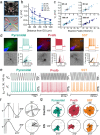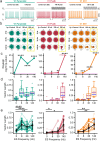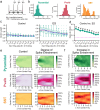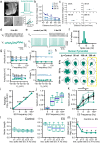This is a preprint.
Cell class-specific electric field entrainment of neural activity
- PMID: 36824721
- PMCID: PMC9948976
- DOI: 10.1101/2023.02.14.528526
Cell class-specific electric field entrainment of neural activity
Update in
-
Cell-class-specific electric field entrainment of neural activity.Neuron. 2024 Aug 7;112(15):2614-2630.e5. doi: 10.1016/j.neuron.2024.05.009. Epub 2024 Jun 4. Neuron. 2024. PMID: 38838670 Free PMC article.
Abstract
Electric fields affect the activity of neurons and brain circuits, yet how this interaction happens at the cellular level remains enigmatic. Lack of understanding on how to stimulate the human brain to promote or suppress specific activity patterns significantly limits basic research and clinical applications. Here we study how electric fields impact the subthreshold and spiking properties of major cortical neuronal classes. We find that cortical neurons in rodent neocortex and hippocampus as well as human cortex exhibit strong and cell class-dependent entrainment that depends on the stimulation frequency. Excitatory pyramidal neurons with their typically slower spike rate entrain to slow and fast electric fields, while inhibitory classes like Pvalb and SST with their fast spiking predominantly phase lock to fast fields. We show this spike-field entrainment is the result of two effects: non-specific membrane polarization occurring across classes and class-specific excitability properties. Importantly, these properties of spike-field and class-specific entrainment are present in cells across cortical areas and species (mouse and human). These findings open the door to the design of selective and class-specific neuromodulation technologies.
Conflict of interest statement
Competing Interests: SYL consults for Starfish Neuroscience, Inc. CAA and SYL are listed as inventors on a patent application related to this work. CK is a Board Member and has a financial interest in Intrinsic Powers Inc.
Figures






References
-
- Hitzig E. (1874). Untersuchungen über das Gehirn: Abhandlungen physiologischen und pathologischen Inhalts (A. Hirschwald).
-
- Fritsch G. (1870). Uber die elektrische Erregbarkeit des Grosshirns. Arch, anat. Physiol. Wiss. Med. 37, 300–332.
-
- Dumitrascu O.M., Kamiński J., Rutishauser U., and Tagliati M. (2016). Subthalamic Nuclei Deep Brain Stimulation Improves Color Vision in Patients with Parkinson’s Disease. Brain Stimulation: Basic, Translational, and Clinical Research in Neuromodulation 9, 948–949. 10.1016/j.brs.2016.08.006. - DOI - PubMed
-
- Vitek J.L., Jain R., Chen L., Tröster A.I., Schrock L.E., House P.A., Giroux M.L., Hebb A.O., Farris S.M., Whiting D.M., et al. (2020). Subthalamic nucleus deep brain stimulation with a multiple independent constant current-controlled device in Parkinson’s disease (INTREPID): a multicentre, double-blind, randomised, sham-controlled study. The Lancet Neurology 19, 491–501. 10.1016/S1474-4422(20)30108-3. - DOI - PubMed
Publication types
Grants and funding
LinkOut - more resources
Full Text Sources
Miscellaneous
